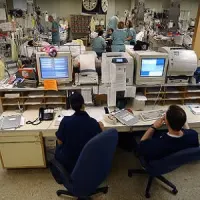In a general ICU population, an abnormal microcirculation at baseline is an independent predictor for mortality, according to results of the MicroDAIMON (Microcirculation DAIly MONitoring in critically ill patients) study. In this setting, additional routine daily microcirculatory monitoring did not reveal extra prognostic information.
The MicroDAIMON study is currently the largest prospective longitudinal observational study to describe the incidence of microcirculatory derangements among a mixed group of critically ill patients (n=97), offering a day-by-day follow-up. The incidence of baseline microcirculatory flow abnormalities was 20.6 percent, and more than half (55.7 percent) of the patients displayed an abnormal Microvascular Flow Index (MFI) < 2.6 in at least one observation during ICU stay.
This single-centre study included adult patients admitted to a 12-bed ICU in an Italian teaching hospital. Sublingual microcirculation was evaluated daily, from admission to discharge/death, using Sidestream Dark Field imaging. Videos were analysed offline to assess flow and density variables. Laboratory and clinical data were recorded simultaneously. A priori, a Microvascular Flow Index (MFI) < 2.6 was defined as abnormal. A binary logistic regression analysis was performed to evaluate the association between microcirculatory variables and outcomes; a Kaplan–Meier survival curve was built. Outcomes were ICU and 90-day mortality.
A total of 97 patients were included in the analysis. An abnormal MFI was present on day 1 in 20.6 percent, and in 55.7 percent of cases during ICU admission. Patients with a baseline MFI < 2.6 had higher ICU, in-hospital and 90-day mortality (45 vs. 15.6%, p = 0.012; 55 vs. 28.6%, p = 0.035; 55 vs. 26%, p = 0.017, respectively). An independent association between baseline MFI < 2.6 and outcome was confirmed in a binary logistic analysis (odds ratio 4.594 [1.340–15.754], p = 0.015).
A heart rate (HR) ≥ 90 bpm was an adjunctive predictor of mortality. However, a model with stepwise inclusion of mean arterial pressure < 65 mmHg, HR ≥ 90 bpm, lactate > 2 mmol/L and MFI < 2.6 did not detect significant differences in ICU mortality. In case an abnormal MFI was present on day 1, ICU mortality was significantly higher in comparison with patients with an abnormal MFI after day 1 (38 vs. 6%, p = 0.001), indicating a time-dependent significant difference in prognostic value.
"The main finding of this study is that in this mixed ICU population, an abnormal baseline MFI is independently associated with unfavourable outcome in terms of ICU, in-hospital and 90-day mortality. In addition, the contemporary presence of tachycardia showed an additive predictive power towards mortality in the survival analysis," the study authors explain.
However, the authors note that the change in MFI over time was not associated with outcome, in terms of both organ failure (SOFA) and mortality. "In contrast to an abnormal MFI on day 1, we could not associate an abnormal MFI after day 1 with unfavourable outcome. No associations were found between the other microvascular variables and outcome," the authors write.
They also say that further studies are needed to incorporate microcirculatory monitoring into a set of currently available haemodynamic variables and to establish its value as a tool to guide specific resuscitation strategies.
Source: Annals of Intensive Care
Image Credit: Publicdomainpictures.net
References:
Scorcella C et al. (2018) MicroDAIMON study: Microcirculatory DAIly MONitoring in critically ill patients: a prospective observational study. Ann. Intensive Care 2018 8:64 https://doi.org/10.1186/s13613-018-0411-9
Latest Articles
ICU, microcirculation, MicroDAIMON, Microcirculation DAIly MONitoring
In a general ICU population, an abnormal microcirculation at baseline is an independent predictor for mortality, according to results of the MicroDAIMON (Microcirculation DAIly MONitoring in critically ill patients) study. In this setting, additional rout










